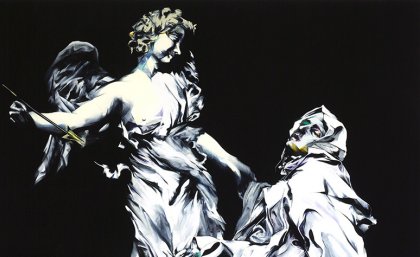
Almost four centuries after its creation, Gian Lorenzo Bernini's Ecstasy of Saint Teresa (1647–52) has inspired a new exhibition opening at UQ Art Museum on 16 September.
Bringing together historical depictions of ecstasy with more recent artworks focused on the transcendence of normal consciousness, Ecstasy: Baroque and Beyond explores how Baroque style – typically associated with high drama, extravagance, frenzy, and excess – continues to inform contemporary art.
The exhibition is a partnership between UQ Art Museum and the UQ Node of the Australian Research Council Centre of Excellence for the History of Emotions (CHE).
Exhibition curator and CHE researcher Dr Andrea Bubenik said the enduring fascination with Bernini’s sculpture was due not only to its technical brilliance and beauty, but also to its eroticism, which surprises those who are accustomed to more sober depictions of saints.
“Saint Teresa, a sixteenth-century Spanish nun, who wrote extensively about her mystical and transcendent experiences, certainly makes for a fascinating subject,” Dr Bubenik said.
“A number of artists featured in the exhibition, including American artist Audrey Flack and Australians Anastasia Booth and Nigel Milsom, have interpreted Bernini’s sculpture, and it’s compelling to see how their adaptions invest Teresa with fresh contemporary appeal.
“Among the work by 17 artists, we’re also very fortunate to include in the exhibition the bronze sculpture Arched Figure by Louise Bourgeois, one of the most important artists of the twentieth century.
“Bourgeois’ sculpture is a headless male figure placed in a position traditionally linked with hysteria – and without resorting to facial expression, she shows us an intense emotional experience registered in the physical form.”
Dr Bubenik said that while, historically, ecstasy was often a very public emotion on display – from religious trances to communal mythological celebrations – in modern times it tended to be relegated to the private sphere.
“For a seventeenth-century artist like Bernini, it was not just about depicting ecstasy; there was also an expectation that viewers experience ecstasy for themselves,” Dr Bubenik said.
“So I’m hopeful that visitors to the exhibition will be inspired to think about what a modern ecstatic experience can encompass, particularly if appreciating terrific art is a feature!”
UQ Art Museum Director Dr Campbell Gray said that the exhibition showed how ecstasy had been reimagined by artists as diverse as Salvador Dalí, Bill Henson, Petrina Hicks, William Hogarth, Gordon Matta-Clark, David Stephenson, and Hiromi Tango.
“Dr Bubenik has told this story through remarkable works loaned by major institutions and private collections,” Dr Gray said.
“Yes, there are images of ecstatic saints, bacchanalian revels and Baroque church domes, but visitors will also discover Gordon Matta-Clarks’s video Office Baroque of 1977, when he famously carved sections out of a building in Antwerp as an architectural intervention.
“Elsewhere, they can enjoy a painting by David Wadelton that portrays Aussie rules players experiencing a moment of sporting ecstasy.”
Ecstasy: Baroque and Beyond runs until 25 February 2018. A program of free events begins with the public forum ‘Ecstasy: Art, Literature, Religion, History’ on Saturday 16 September, 8.30am to 1.00pm (full details at www.artmuseum.uq.edu.au).
Accompanying the exhibition are screenings at the Art Museum of two international films: Simon Palfrey’s Demons Land: a poem come true (2016), 16 September to 9 November 2017; and Mieke Bal’s Reasonable Doubt (2015), 10 November 2017 to 25 February 2018.
Download images for print and web here
Media: Sonia Uranishi, sonia@soniauranishicommunication.com, +61 409 387 623; Sebastian Moody, s.moody@uq.edu.au, +61 7 3346 8761.
Featured image:
Nigel Milsom
Judo House Part 6 (The White Bird) 2014–15
oil on linen
Collection of Art Gallery of New South Wales. Contemporary Collection Benefactors 2015, with the generous assistance of Alenka Tindale, Peter Braithwaite, Anon, Chrissie & Richard Banks, Susan Hipgrave & Edward Waring, Abbey & Andrew McKinnon
Reproduced courtesy of the artist and yuill|crowley, Sydney.
.jpg)


